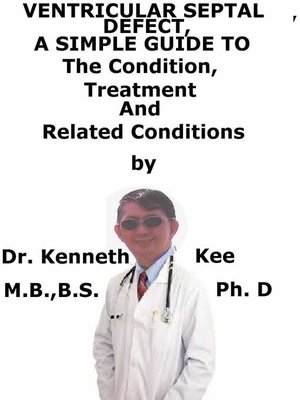Ventricular Septal Defect, a Simple Guide to the Condition, Treatment and Related Conditions
ebook
By Kenneth Kee

Sign up to save your library
With an OverDrive account, you can save your favorite libraries for at-a-glance information about availability. Find out more about OverDrive accounts.
Find this title in Libby, the library reading app by OverDrive.



Search for a digital library with this title
Title found at these libraries:
| Loading... |
Ventricular septal defect is the presence of one or more holes in the wall that separates the right and left ventricles of the heart.
Ventricular septal defect is one of the most common congenital heart defects.
The defect may occur by itself or with other congenital diseases.
Ventricular septal defect (VSD) is failure of development of the septum between the two ventricles of the heart.
The ventricles are a single chamber at about 4 weeks' gestation but by 8 weeks it has been divided in two.
Failure of development of any part of the septum results in a defect
Congenital heart defects are problems with the heart's structure that are present at birth.
These defects change the normal flow of blood through the heart.
During pregnancy the right and left ventricles of its heart of the fetus are not separated.
As the fetus grows, a wall forms to separate these two ventricles.
The heart has two sides, separated by an inner wall called the septum.
The septum prevents mixing of blood between the two sides of the heart.
If the wall is not completely formed, a hole remains.
The most common symptoms are:
1. Shortness of breath
2. Fast breathing
Ventricular septal defect is diagnosed by:
1. A heart murmur
2. Echocardiogram
Treatment is by:
Many small defects will close by themselves and is not treated
If the opening is large, open-heart surgery may be needed to close it and prevent serious problems.
Most surgery for VSD repair is done by the first year.
Normally a patch of fabric or pericardium (the normal lining around the outside of the heart) is sewn over the VSD to close it completely.
Anyone who had surgery for a VSD requires a regular check up with a cardiologist who is experienced with adults with congenital heart defects
Medications are rarely needed.
The long-term outlook is good .
TABLE OF CONTENT
Introduction
Chapter 1 Ventricular Septal Defect
Chapter 2 More Facts of VSD
Chapter 3 Treatment of VSD
Chapter 4 ASD
Chapter 5 PDA
Chapter 6 Tetralogy of Fallot
Chapter 7 Coarctation of the Aorta
Chapter 8 Congenital Heart Diseases
Epilogue






